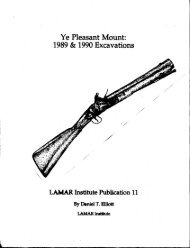Stirring Up a Hornet's Nest: - UGA Laboratory of Archaeology ...
Stirring Up a Hornet's Nest: - UGA Laboratory of Archaeology ...
Stirring Up a Hornet's Nest: - UGA Laboratory of Archaeology ...
Create successful ePaper yourself
Turn your PDF publications into a flip-book with our unique Google optimized e-Paper software.
might have turned in their favor. Once Boyd was incapacitated by his wounds and unable to command, the<br />
group cohesion <strong>of</strong> the Loyalists around him deteriorated and they fled in panic. Since Dooly’s and Clarke’s<br />
troops surrounded them to the east and west and Pickens men were to the north, southward across Kettle<br />
Creek was their only option.<br />
Pickens recalled, “The action then became general and (warm) confused for about twenty minutes, they<br />
called for us much out <strong>of</strong> the cover,” which suggests that the Loyalists stayed in the canebrake for some<br />
time before crossing Kettle Creek. Pickens was frustrated that Dooly’s and Clarke’s men were stalled in the<br />
canebrake as he later wrote, “The divisions on the flank did not press as I wished them to cross the creek<br />
above and below. This was not for want <strong>of</strong> courage but for want <strong>of</strong> experience and knowledge <strong>of</strong> the<br />
necessity <strong>of</strong> obeying orders” (Pickens 1811). Pickens went on to say that the Loyalists “retreated across the<br />
creek and formed on a rising ground. We pressed though the cane, the action was renewed mor[e]<br />
obstinately and continued near half an hour - As they had the advantage <strong>of</strong> the grounds they contended<br />
obstinately but at length gave way” (Pickens 1811). In his account Pickens does not give Elijah Clarke any<br />
credit for being the first to cross the creek or engage in the final phase <strong>of</strong> the battle. The place where the<br />
Loyalists had “the advantage <strong>of</strong> the grounds” was at Locus F in the present survey.<br />
Figure 45 is a schematic diagram <strong>of</strong> the suspected firing positions and troop movements <strong>of</strong> the Patriots and<br />
Loyalists in the battle at Kettle Creek. This version <strong>of</strong> the battle is derived from a synthetic analysis <strong>of</strong> the<br />
historical and archeological research conducted as part <strong>of</strong> this study.<br />
The present study examined most <strong>of</strong> the areas confined within McDaniel’s study area (McDaniel 2002a).<br />
This encompassed many hectares, however, and the fieldwork lasted only 10 days with a small field crew,<br />
so the coverage was not 100 percent. This work constitutes a reconnaissance survey <strong>of</strong> the entire battlefield<br />
with specific areas receiving more focused scrutiny. Many areas were identified that are relevant to the<br />
battle, which confirmed that McDaniel’s battlefield size estimate was relatively accurate.<br />
Defining Battlefield Features are the essential components in Battlefield Archeology for an accurate<br />
interpretive reconstruction <strong>of</strong> a historic battle. These features are tangible. They include natural<br />
topographic features, cultural improvements such as farms, roads, fences, mills, agricultural fields, etc.<br />
(existing at the time <strong>of</strong> the battle), military barricades, entrenchments, or fortifications, fields <strong>of</strong> fire,<br />
cemeteries, and other associated geographically definable features. Defining Battlefield Features for the<br />
Kettle Creek battlefield included:<br />
� Kettle Creek (Channelized but largely the same as shown on modern maps)<br />
� Canebrake or Swamp (Bottoms between Loci E, C, B, F, and H)<br />
� Monument Knoll (Loci A and B)<br />
� Hill on south side <strong>of</strong> Kettle Creek (Locus F)<br />
� Fence line on knoll slope (not located)<br />
� Archibald Simpson’s (or Mr. Nelson’s) farmstead (not located)<br />
� James Hammett’s farmstead (Locus E)<br />
� Simpson’s (or Nelson’s) Cow pen (possibly between Loci C and E)<br />
� Loyalists camp (Locus E)<br />
� Wrightsborough Road (Locus F)<br />
� Road to Carr’s Station (Locus D)<br />
� Road to Heard’s Fort (Locus D)<br />
� Joel Phillip’s Fort (not located)<br />
� Slaton’s Mill seat (not located)<br />
� Robert McNabb’s Fort (not located)<br />
� McGirth’s camp on Little River (not located)<br />
� Battlefield graveyard (not located)<br />
� Ford across Kettle Creek (between Loci A and F)<br />
The battle at Kettle Creek lasted less than three hours but the participants, who were on horseback and on<br />
foot, covered considerable distances over the course <strong>of</strong> the battle. The result is that the battlefield is spread<br />
over several hundred hectares. Following ABPP survey protocol the results <strong>of</strong> the present historical<br />
165










